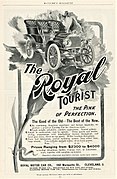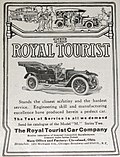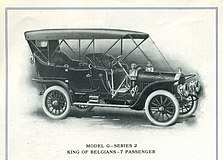Royal Motor Company
Automobiles |
Royal Motor Car Company was a
History
In November 1903, Edward Shurmer took over the
Later that same year a 4-cylinder 32/35-hp Model K was introduced on the same chassis, priced at $3,000, and for 1904 total production was 100 cars.[1] Robert Jardine, a Frenchman with extensive European experience was hired as the chief engineer.[2]
The twin-cylinder was dropped and the company built successively larger motor cars, increasing to 40 and 45-hp and priced from $3,500 to $4,000. In 1907 a $5,000 (equivalent to $163,500 in 2023) limousine was introduced. In 1905 a factory Royal Tourist participated in the Vanderbilt Cup trials but was not selected for the race. The Royal Tourist was extensively advertised as the car that placed third in the trials.[2]
Royal Tourists were known as big, luxurious and reliable cars and used the slogan "The Pink of Perfection” in early advertising. The roundness of radiator, hood and cowl was a distinguishing design of the Royal Tourist for all of its production. In 1906, the first reorganization occurred and the company was renamed the Royal Motor Car & Manufacturing Company.[2][1]
In September 1907 the Royal Tourist moved into a new factory. In November 1907, with the effects of the Panic of 1907, the company went into receivership. In December 1908, a court judge authorized the sale of the company's assets to a new corporation named the Royal Tourist Car Company, headed by Bostonian, George Dunham.[1][2]
Robert Jardine had developed a six-cylinder motor for the Royal Tourist but the financial issues resulted in its cancellation. A novel idea for 1909 Royal Tourist's was Its horn placed under the hood, with only the bulb for sounding it at the center of the steering wheel hub. This was claimed as a first.[2][1]
In March, 1911 Royal Tourist Car Company merged with Croxton Motor Car Company of Cleveland and the Acme Body & Veneer Company of
Advertisements
-
1904 Royal Tourist advertisement
-
1906 Royal Tourist advertisement
-
1907 Royal Tourist advertisement
-
1910 Royal Tourist advertisement
Model Gallery
-
1905 Model F 32/38 hp 4-cylinder Touring Car
-
1907 Model G 45 hp Tulip Body Touring Car
-
1907 Model G 45 hp 'King of Belgians' Body Touring Car
See also
- The Royal Tourist in the Vanderbilt Cup Races
- Royal Tourist at ConceptCarz
- Frank Leslie's Popular Monthly (January, 1904)
References
- ^ ISBN 1-57958-293-1.
- ^ ISBN 978-0-87341-428-9.







